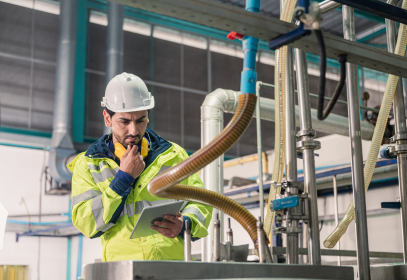In this episode we are going to be starting at the beginning of the life of equipment within a facility. As anyone who has worked in a manufacturing facility knows, repair of equipment frequently starts before the equipment is ever used.
Additionally, if the facility intends to put the equipment on a preventive maintenance schedule, the schedule should start as the equipment is installed and first run to assure that the equipment upkeep is accounted for as soon as possible.
Integrating new equipment into a quality and safety management system involves several formal considerations.For a facility, the equipment may be added to the process flow chart, the food safety plan hazard analysis, and/or the cleaning and sanitation schedule. In addition to these considerations, maintenance and repair actions to the equipment must be assessed starting at the point of installation, and this includes proper equipment placement in the facility, as well as required adjustments and calibration to ensure the equipment is functioning effectively before use during a production run.
We strongly recommend creating a physical or electronic folder for each new piece of equipment that includes the information starting at the receipt of the equipment into the facility. The folder should include the date of first inspection, identified issues such as equipment that is delivered with misalignments or defects as well as results of trial runs with the equipment.
Regardless of whether the equipment works as intended at the start or not, a written statement of the circumstances are crucial reference points for understanding the maintenance and repairs that were performed on the equipment during installation and test runs can be very useful for later assessment and root cause investigations.
Starting at the shipment from the manufacturer, or receipt within the facility, assessment of the equipment should be performed to determine points where preventive maintenance is required. User manuals for the equipment typically specify upkeep activities for the equipment, and it is recommended to perform all manufacturer specified maintenance items to maintain any warranties and comply with best practices.
Talking with the equipment manufacturer’s sales or technical service staff may also be helpful. If it is a large enough piece of equipment, the manufacturer may send a representative to help with installation and training. If so, make sure to document preventive maintenance and sanitation recommendations during that visit.
The employees responsible for maintenance may determine that actions not called out in the user manual should also be added, and these should be included in preventive maintenance as well.
The equipment should be added to the preventive maintenance schedule prior to installation. All preventive maintenance actions should be listed, as well as the frequency at which those actions shall occur . Additionally, a log or form detailing the maintenance actions should be filled out each time the preventive action on the new equipment is completed to demonstrate that preventive maintenance is occuring at the designated frequency.
In any situation where equipment is not working when it is initially brought into the facility, the repairs made to the new equipment should be treated in the same way that repairs to existing equipment are treated.
By this, we mean that a work order on the equipment should be filled out, and a description of the work, the parts, and the efforts to clean up and remove tools after the repair should be performed. It also means that there may be multiple work orders created in any situation where multiple problems are discovered as part of the installation.
The work order allows us to assign a repair task, document when the repair was performed, who it was performed by, and also document any sanitation practices that were required and performed.
Leadership should make new equipment installation and assessment a top priority for management review activities and stress the proper recording of maintenance assessments and repair for all new equipment.
For properly installed equipment, and for ongoing operations, preventive maintenance and repair provide us with a key performance metric to determine if we are in control of our program.
In our next episode, we are going to look at ongoing preventive maintenance for operations, and how preventive maintenance is controlled as part of a properly functioning quality and safety management system.
Thank you for watching. For more food safety & quality management system training videos and resources, please consider subscribing to our YouTube Channel or follow us on LinkedIn.
Thank you for watching. For free downloads to accompany this video series, visit the free training videos & resources page of our website.
Subscribe to our YouTube channel or follow us on LinkedIn to be notified of new educational food safety resources.



